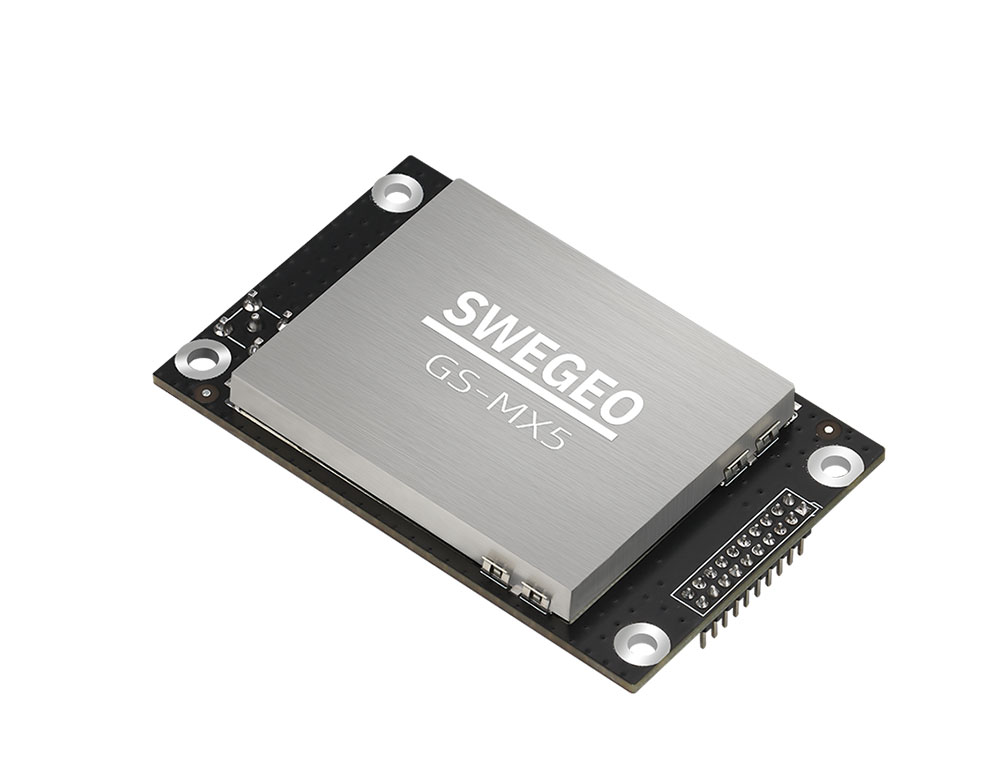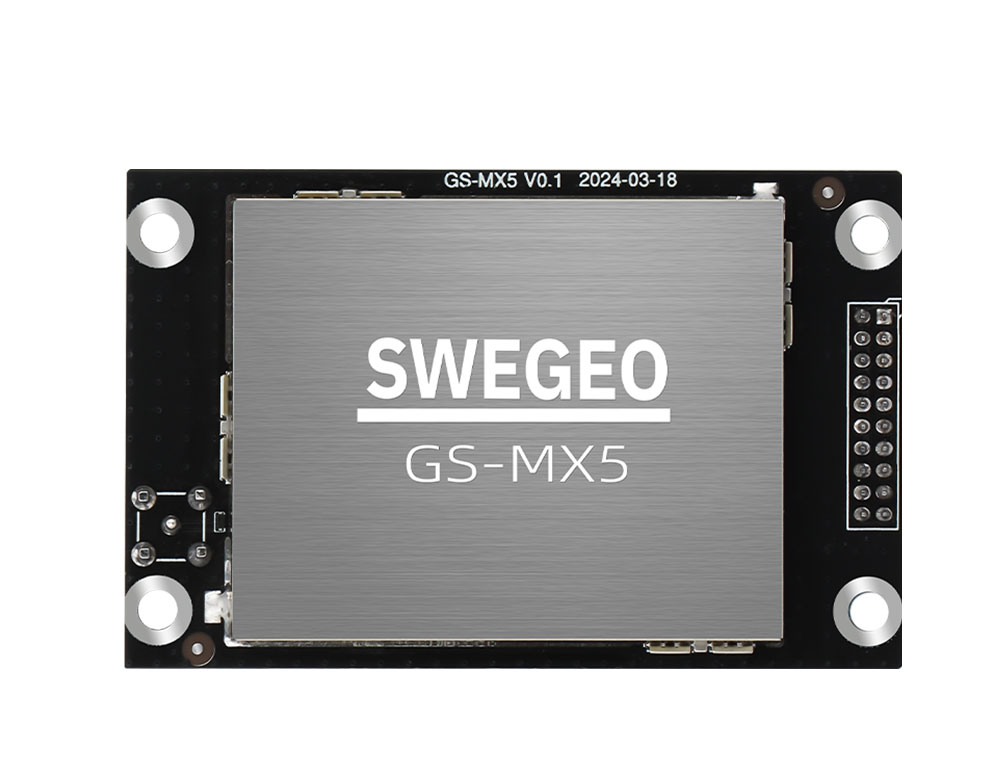

Swegeo GS-MX5
Single Antenna GNSS Receiver Board
Key Feature
The Swegeo GS-MX5 board offers exceptional GNSS positioning capabilities, designed for mass market applications including robotics and autonomous systems. It features a multi-constellation receiver that supports tracking of all Global Navigation Satellite System (GNSS) constellations and is compatible with both current and future signal formats. The board is equipped with advanced interference mitigation technology, providing robust performance even in challenging environments. With a low-power design and a wide array of interfaces, the Swegeo GS-MX5 ensures high reliability and precision, setting a new benchmark for GNSS positioning solutions
Small in size, big in performance
The board is compact in size but delivers high performance, combining a small form factor with powerful capabilities to fit various applications without compromising on functionality.
All-in-view satellite tracking: multi-constellation, multi-frequency
The board can track satellites from all available GNSS constellations (GPS, GLONASS, Galileo, BDS, QZSS) and operate across multiple frequencies, ensuring comprehensive and precise positioning data regardless of satellite availability or signal type.
Best-in-class reliable and scalable position accuracy
The board offers top-tier positioning accuracy that is both reliable and scalable, making it suitable for a wide range of applications from everyday use to high-precision requirements.
Future proof: supporting current and future satellite signals
Designed to be forward-compatible, the board supports not only existing satellite signals but also upcoming signals, ensuring long-term usability and adaptability as new technologies emerge.
AIM+ unique interference mitigation and monitoring system as part of the advanced GNSS+ algorithms
Features AIM+ technology, which provides advanced interference mitigation and monitoring. This system uses sophisticated algorithms to reduce the impact of signal interference, ensuring accurate performance even in challenging environments.
Update rate of 100 Hz
The board has a high update rate of 100 Hz, meaning it can refresh positioning data 100 times per second, providing real-time, precise tracking and responsiveness.
Industry-leading ultra-low power consumption
Designed with energy efficiency in mind, the board consumes very little power while maintaining high performance, making it ideal for battery-operated and energy-sensitive applications.
Easy-to-integrate, optimized for automated assembly
The board is designed for easy integration into various systems and is optimized for automated assembly processes, streamlining production and reducing integration time.
Robotics & Automation (Mass Deployment):
The GS-MX5 is designed for mass-market autonomous systems, making it a go-to for robotics companies scaling up production. For example, a manufacturer of warehouse robots or last-mile delivery bots can use this board to ensure each unit has reliable cm-level navigation. Thanks to its advanced interference mitigation (AIM+ technology), even if dozens of robots operate in the same area with various wireless devices, each robot’s GNSS remains accurate and stable. The ultra-low power consumption and small size also mean robots can be smaller and run longer on a battery charge, which is a significant competitive advantage in the logistics and delivery sectors.
High-Performance UAV Fleets:
When deploying fleets of professional drones (for surveillance, mapping, or industrial inspection), the GS-MX5 provides the needed precision and update rate. Its ability to output positions at up to 100 Hz means fast-moving drones or those making quick turns receive nearly instantaneous location feedback, leading to smoother flight control and the ability to capture data at high speed (for instance, tracking dynamic targets or inspecting power lines from a moving drone). Drone fleet operators also appreciate the board’s future-proof, multi-frequency design – as new Galileo or BeiDou signals come online, the hardware is already compatible, ensuring longevity of their UAV investment.
Precision Timing & Network Synchronization:
Apart from positioning, the GS-MX5’s high update rate and time pulse outputs can be used in applications like timing synchronization for telecommunications or scientific equipment. For instance, a company setting up a distributed sensor network (across an earthquake-prone region or a large industrial facility) could use one GS-MX5 at each sensor node not only to know the exact location of that sensor, but also to provide a precise time reference (via its PPS signal). Each board’s 100 Hz data and nanosecond-level time accuracy ensure that data collected at different locations can be correlated perfectly in time and space, which is vital for analysis in such applications.
| Feature | Specification | Feature | Specification |
|---|---|---|---|
| Signal Support |
GPS: L1C/A, L1PY, L2C, L2P, L5 GLONASS: L1CA, L2CA, L2P, L3 CDMA BeiDou: B1I, B1C, B2a, B2b, B2I, B3 Galileo: E1, E5a, E5b, E5 AltBOC, E6 QZSS: L1C/A, L1 C/B, L2C, L5 NavIC: L5 SBAS: EGNOS, WAAS, GAGAN, MSAS, SDCM (L1, L5) L-Band: On module |
Channels | 448 Channels |
| Horizontal Accuracy | 0.6 cm + 0.5 ppm | Vertical Accuracy | 1 cm + 1 ppm |
| Other Positioning Modes |
Standalone: 1.2 m / 1.9 m (H/V) SBAS: 0.6 m / 0.8 m (H/V) DGNSS: 0.4 m / 0.7 m (H/V) |
Velocity Accuracy | 3 cm/s |
| Data Update Rate |
Position: up to 100 Hz Measurements: up to 100 Hz |
Latency | < 10 ms |
| Time to First Fix |
Initialization: 7 s Cold Start: < 45 s Warm Start: < 20 s Reacquisition: 1 s |
Time Precision |
xPPS Out: 5 ns Event Accuracy: < 20 ns |
| Dimensions | 71.1 × 45.7 × 1.62 mm | Weight | 644 g |
| Input Voltage | 3.3 V DC | Connectors |
RS232 × 2 USB × 1 Bluetooth (Long Range SPP) |
| Operating Temperature | -40°C to +85°C | Storage Temperature | -55°C to +85°C |
| Humidity | 5% - 95% (non-condensing) | Vibration / Shock | MIL-STD-810G |


Swegeo GS-MX5
Dual Antenna GNSS/INS Receiver Board
Key Feature
The Swegeo GD21D-INS board is designed to deliver high-precision navigation capabilities in a compact form factor. It features advanced anti-jamming technology with 65 dBc narrowband suppression and high-performance RTK for reliable positioning. The board offers a deeply-coupled combined navigation solution to address challenges such as satellite signal interference and multipath effects. It provides continuous, real-time, and accurate position and attitude information, making it ideal for applications including automated driving, drones, precision agriculture, surveying, and mapping.
OVERVIEW
Multi-Constellation GNSS Support
Provides reliable and robust signal reception from GPS, GLONASS, Galileo, and
BeiDou systems, ensuring comprehensive coverage and improved accuracy.
Dual Antenna Configuration
Enhances positioning accuracy and performance, particularly in challenging
environments, by using two antennas to better mitigate signal obstructions and
multipath effects.
USE CASES
Robotics & Automation (Mass Deployment):
The GS-MX5 is designed for mass-market autonomous systems, making it a go-to for robotics companies scaling up production. For example, a manufacturer of warehouse robots or last-mile delivery bots can use this board to ensure each unit has reliable cm-level navigation. Thanks to its advanced interference mitigation (AIM+ technology), even if dozens of robots operate in the same area with various wireless devices, each robot’s GNSS remains accurate and stable. The ultra-low power consumption and small size also mean robots can be smaller and run longer on a battery charge, which is a significant competitive advantage in the logistics and delivery sectors.
High-Performance UAV Fleets:
When deploying fleets of professional drones (for surveillance, mapping, or industrial inspection), the GS-MX5 provides the needed precision and update rate. Its ability to output positions at up to 100 Hz means fast-moving drones or those making quick turns receive nearly instantaneous location feedback, leading to smoother flight control and the ability to capture data at high speed (for instance, tracking dynamic targets or inspecting power lines from a moving drone). Drone fleet operators also appreciate the board’s future-proof, multi-frequency design – as new Galileo or BeiDou signals come online, the hardware is already compatible, ensuring longevity of their UAV investment.
Precision Timing & Network Synchronization:
Apart from positioning, the GS-MX5’s high update rate and time pulse outputs can be used in applications like timing synchronization for telecommunications or scientific equipment. For instance, a company setting up a distributed sensor network (across an earthquake-prone region or a large industrial facility) could use one GS-MX5 at each sensor node not only to know the exact location of that sensor, but also to provide a precise time reference (via its PPS signal). Each board’s 100 Hz data and nanosecond-level time accuracy ensure that data collected at different locations can be correlated perfectly in time and space, which is vital for analysis in such applications.
APPLICATIONS


TECHNICAL SPECIFICATIONS
| Feature | Specification | Feature | Specification |
|---|---|---|---|
| Signal Support |
GPS: L1C/A, L1PY, L2C, L2P, L5 GLONASS: L1CA, L2CA, L2P, L3 CDMA BeiDou: B1I, B1C, B2a, B2b, B2I, B3 Galileo: E1, E5a, E5b, E5 AltBOC, E6 QZSS: L1C/A, L1 C/B, L2C, L5 NavIC: L5 SBAS: EGNOS, WAAS, GAGAN, MSAS, SDCM (L1, L5) L-Band: On module |
Channels | 448 Channels |
| Horizontal Accuracy | 0.6 cm + 0.5 ppm | Vertical Accuracy | 1 cm + 1 ppm |
| Other Positioning Modes |
Standalone: 1.2 m / 1.9 m (H/V) SBAS: 0.6 m / 0.8 m (H/V) DGNSS: 0.4 m / 0.7 m (H/V) |
Velocity Accuracy | 3 cm/s |
| Data Update Rate |
Position: up to 100 Hz Measurements: up to 100 Hz |
Latency | < 10 ms |
| Time to First Fix |
Initialization: 7 s Cold Start: < 45 s Warm Start: < 20 s Reacquisition: 1 s |
Time Precision |
xPPS Out: 5 ns Event Accuracy: < 20 ns |
| Dimensions | 71.1 × 45.7 × 1.62 mm | Weight | 644 g |
| Input Voltage | 3.3 V DC | Connectors |
RS232 × 2 USB × 1 Bluetooth (Long Range SPP) |
| Operating Temperature | -40°C to +85°C | Storage Temperature | -55°C to +85°C |
| Humidity | 5% - 95% (non-condensing) | Vibration / Shock | MIL-STD-810G |


